Online MBA Asynchronous Discussion Workload and Value Perceptions for Instructors and Learners: Working Toward an Integrated Educational Model for Professional Adults
|
Zvi Goldman
Academic Program Manager – MBA Program
Malcolm Baldrige School of Business
Post University
Waterbury, CT 06723 USA
zgoldman@post.edu
Abstract
This paper reviews the outcomes of a year-long survey examining the perceived workload and value of asynchronous discussion shared by MBA adult learners and instructors engaged in the same classes. Results are characterized for each stakeholder group (instructors or learners) and compared between them. The different response profiles of learners and instructors are discussed as well as the implications for the Discussion Guideline introduced last year. Class size and course level had a differentiating impact on learners and instructors. The research further found a significant relationship between learners and instructors on workload perception, but not on hours spent or value perception. The implications of course and discussion design for an adult learner educational model are discussed.
Keywords: MBA, adult learners, online education, distance education, asynchronous discussion, workload perception, value perception, best practices, adult education model |
Introduction and Challenge
The engagement of learners with their instructor and peers in synchronized online courses and discussions is critical for learning, value perception, satisfaction, and retention (Bedi, 2008; Bocchi, Eastman, & Swift, 2004; Mandernach, Dailey-Hebert, & Donnelli-Sallee, 2007). Valuable and productive online discussions are not serendipitous; typically, they are the result of careful design and management (Chen, Wang, & Hung, 2009; Wang & Chen, 2008).
In an earlier paper published in JOLT, Goldman (2011a) described an MBA Discussion Guideline, launched to facilitate asynchronous online discussions for adult practitioner stakeholders, including learners and instructors. The Discussion Guideline was designed and deployed to promote a higher level of engagement and balance education workload and value perceptions for both learners and instructors (see the summary of the Discussion Guideline provided in Appendix A). It was hypothesized that following the introduction of the Discussion Guideline: (1) discussion would become the major engagement conduit for all involved and consume most of the course time for learners and instructors; (2) discussion would be highly valued by learners while the consequential load perception would be capped at a high, yet acceptable, level for learners and instructors; and (3) hours spent on discussion, by design or consequence, could serve to indicate/predict value perception for learners.
The broader goal of this study was to expand on the Discussion Guideline's all-inclusive approach and explore learners' and instructors' perceptions of balance between workload and value utilizing a systemic/holistic point of view, an approach that had not previously been explored. It was anticipated that such an approach would prove valuable in terms of the design and management of better applicable education processes for adult professional stakeholders.
Literature Review
A recent general review of asynchronous discussion success factors and performance assessment was presented in Andresen (2009). One consequence of an asynchronous delivery mode is an increase in expected workload for instructors. Crews, Wilkinson, Hemby, McCannon, and Wiedmaier (2008) and Conceição and Baldor (2009) described authoring, teaching, institutional, course revision, and improvement strategies to reduce faculty workload associated with online teaching. Specific strategies to reduce asynchronous discussion workload had been suggested earlier by Dunlap (2005). The approach of capped discussion (i.e., satisfaction with a proscribed number of postings above a stated threshold) to control instructor workload was found to be valuable by some researchers but lacking in efficiency by others (reviewed in Dennen, 2005). Controlling class size was also identified as a way to reduce instructor workload (Conceição & Baldor, 2009).
The above articles on faculty workload issues were not linked to the quality and value of online education, nor were they applied to both instructors and learners at the same time (i.e., engaged in same classes). In a brief interview, Scheuermann (2005a, 2005b) commented on the relationship between instructor workload and quality of online discussions, and suggested several design and management strategies to maintain both. Among the recognized strategies was controlling the level of instructor participation and presence (similar to the capped discussion concept utilized in the Discussion Guideline – Goldman, 2011a); however, the balance of workload and quality for learners was not addressed or related to the instructor workload in any systematic or holistic manner.
This study pursues an integrated means of associating workload and value perceptions in online asynchronous discussions shared by learners and instructors engaged in same classes, a systematic approach yet to be investigated in previous studies.
Method
A year-long survey, over six consecutive modules during the period August 2010 to August 2011, was conducted for learners and instructors participating in the online Master of Business Administration (MBA) program offered by Post University in Waterbury, Connecticut, USA. A total of 106 course sections were included; 72 instructor responses and 280 learner responses were obtained. The distribution of learner responses by course level was 27% in Foundation, 48% in Core, 14% in Concentration, and 4% in Capstone project. More details about the demographics of the study sample can be found in Appendix B.
The MBA program consists of three Foundation courses (basic and leveling classes), six Core courses (more advanced classes), four Concentration courses (concentrating on specific topics and disciplines), and two Capstone courses (focusing on research and writing). In general, the expectations from learners and the emphasis on performance assessment progressively increases from Foundation level to the Capstone experience.
Learner assessment in a typical course within the program is based on participation in discussion (worth 30-40% of total course grade) and three to four written assignments (worth 60-70% of total course grade). The typical weekly content includes reading material (40-60 pages a week), multimedia lecture notes, supplemental/optional reading, and video clips. In this study, the measured variables were assessed over the consolidated "discussion" or "course" activities, where "discussion" is inclusive within a "course" (see Appendices C and D for more details).
The survey included similar questions for learners and instructors, inquiring about hours spent, load perception, and value perception (dependent variables) for both the discussion and the course (discussion is part of the course and is the main focus of this paper). Value perceptions were always considered for learners. Additional qualifying independent variables such as class size and course level were recorded. The survey structure and questionnaires are detailed in Appendix C. Ad-hoc definitions of some of the variables explored in the study are given in Appendix D.
Descriptive statistics, analysis of variance (ANOVA), and covariance/correlation analysis were employed to explore the load and value perceptions of learners and instructors as well as to present the results. Unless otherwise indicated, parametric statistics were applied. When arguments could have been advanced for either parametric or non-parametric tests, both were conducted and the more conservative outcome was selected.
In order to provide a complete picture, data and analyses are sometimes presented for both the discussion (the focus in this study) and the course overall. The correlation matrix exploring the relationship between hours spent, load perception, and value perception for discussion and course is presented graphically in order to capture the big picture and main effects. This approach proved more informative in visually presenting the relationships among the dependent variables, and between learners and instructors. Although no formal attempt was made to prove the causality direction between course and discussion, it is reasonable to assume that outcomes associated with discussion affected outcomes associated with course, and not vice versa. As shown in the Results section, discussion consumed more than half of the time spent by either learners or instructors. The template shown in Figure 1 is used to explore the above correlations.
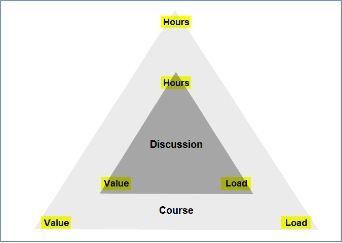
Figure 1. Variables used to explore the correlations in this study
Results
Demographics
- Learner experience. One of the survey items asked learners the following question: "Looking back, how much relevant experience (previous exposure to the taught content) did you have coming into this course?" The responses to this question are shown in Figure 2. Most learners (61%) reported having "some" or a "fair" level of experience entering the course, 25% reported having "none" or "negligible" experience. The stated level of experience significantly shifted upwards as learners advanced from Foundation to Concentration courses (F-test, p = .01).
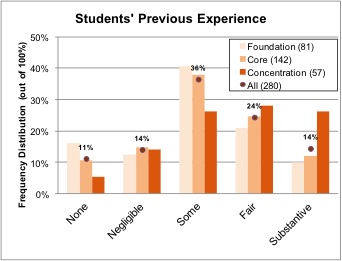
Figure 2. Students' self-reported course-related experience at the Foundation, Core, and Concentration program levels
- Class size. The average class size over the program (for course and discussion), as reported by instructors and confirmed by registration, was 11.4 learners. Significantly smaller class sizes were found at the Concentration level (average of 7.2 learners per class) than for the Foundation and Core levels (average of 13.9 learners per class) (ANOVA, p < .001).
Learners' Responses
- Hours spent by learners. Figure 3 shows the number of hours learners reported spending on online discussions, in response to the survey question, "On average, how many hours per week have you spent on discussions (including reading, researching, posting)?" More than 80% of the learners spent 2-15 weekly hours on discussion (M = 9.4, Mdn = 7.6, Mode = 10). Significantly and progressively, learners spent more time on discussion as they advanced from Foundation- to Concentration-level courses (a significant difference was found in distributions and medians, p < .006). Similarly across all course levels, learners spent, on average, 55% of their course time on discussion.
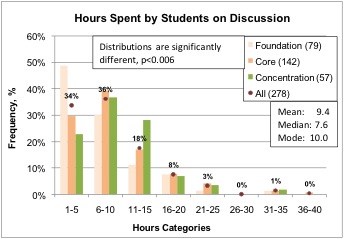
Figure 3. Distributions of hours spent by students on discussion at the various program levels
- Load perception by learners. Figure 4 depicts learners' responses to the survey question, "How would you rate the overall discussion load for you in this class?" The majority of learners (85%) perceived the discussion load to be "medium" or "heavy." Discussion loads were similar for all course levels; learner load perception did not significantly change throughout the program (excluding the Capstone). Learner discussion load perception was only weakly correlated with the number of hours spent on discussion (r = .29, p < .001, n = 279); for any given range of hours spent around the overall mean, substantive distributions of learner hours were found in every load perception category from "minor" to "very heavy."

Figure 4. Distributions of students' discussion load perceptions at the various program levels
- Value perception by learners. In the survey, learners were also asked the question, "How would you rate the overall discussion value for you in this class?" Their responses are summarized in Figure 5. The majority of learners (82%) perceived the discussion to be "fair" to "very high" in value. The value perception significantly increased with learners advancing from Foundation to Core and Concentration courses (significant difference found in distributions, ANOVA, F-test, p = .04). Hours spent on discussion, load perception, and value perception of discussion were found to be unrelated to class size. This observation will be discussed later in conjunction with the Discussion Guideline under which learners operated during the 12 months of the study's data-collection phase.

Figure 5. Distributions of students' discussion value perceptions at the various program levels
- Relationship between hours spent, load perception, and value perception for learners. The correlation matrix in Figure 6 illustrates the relationship between the time spent by learners, their load perception, and their value perception. As can be seen in the figure, course and discussion were highly correlated for hours spent, load perception, and value perception (r > .6 and p < .005 for these correlations). Given that discussion was a significant part of the course (averaging 55% of the total number of hours spent on a course), it is reasonable to conclude that discussion impacted the course (a causality direction for the correlations observed). Hours spent on discussion were significantly correlated with load perceptions of both discussion and course (r = .3 to .5 and p < .005 for these correlations). In contrast to the significant correlation between hours spent and load perception, the correlations between value perception and hours spent and between value perception and load perception were relatively weak. Discussion load perception was only mildly associated with the value perceptions for discussion and course (r = .2, p < .005). The correlations between value perception and hours spent were weak or marginally significant, likely to be a random occurrence given the number of correlations explored.
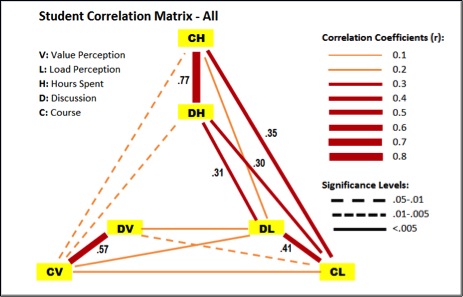
Figure 6. Correlation matrix for students showing relationship between hours spent, load perception, and value perception, for both discussion and course
Instructors' Responses
- Hours spent by instructors. Figure 7 shows the number of hours instructors reported spending on online discussions, in response to the survey question, "On average, how many hours per week have you spent specifically on discussions (including reading, posting, and grading; not including development)?" More than 60% of the instructors spent 7-12 weekly hours on discussion, averaging around 10 hours a week. Only a few instructors (3%) spent more than 15 weekly hours on discussion. Significantly and progressively, instructors spent less time on discussion as courses advanced from Foundation to Concentration levels (significant difference found in distributions, ANOVA, F-test, p < .02). Similarly across all course levels, instructors spent an average of 65% of their course time on discussion.
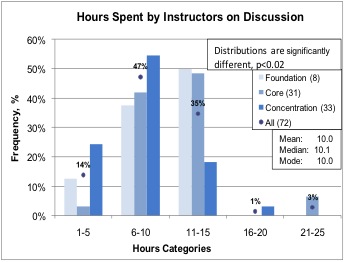
Figure 7. Distributions of hours spent by instructors on discussion at the various program levels
- Load perception by instructors. The instructors' load perception as reported by them in response to the survey question, "How would you rate the overall discussion load for you in this class?" is shown in Figure 8. The majority of instructors (69%) perceived the discussion load to be "medium." Discussion loads were similar for all course levels – instructor load perception did not significantly change throughout the program (excluding the Capstone). Instructor discussion load perception was significantly correlated with the hours spent on discussion (r = .36; p < .003; n = 64); "minor," "medium," "heavy," and "very heavy" workload perceptions were associated with 6, 9.7, 10.8, and 15.5 average weekly hours spent on discussion, respectively. Both hours spent and load perception significantly decreased with smaller class sizes (Correlation r = .33 to .40, p < .005, n = 64). As described above in the Demographics subsection, class sizes in Concentration courses were significantly smaller than those in Foundation and Core courses.
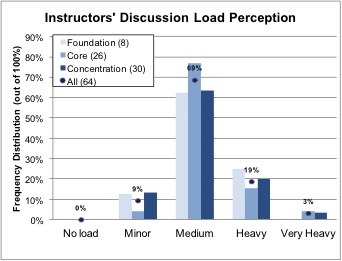
Figure 8. Distributions of instructors' discussion load perceptions at the various program levels
- Value perception by instructors. The instructors' value perception as reported by them in response to the survey question, "How would you rate the overall discussion value for your learners in this class?" is shown in Figure 9. The majority of instructors (89%) perceived "high" to "very high" values of the discussion for learners. The value perception did not significantly change with course level. Value perception of discussion was completely unrelated to class size (and course level); this observation will be discussed later in conjunction with the overall instructors' response.
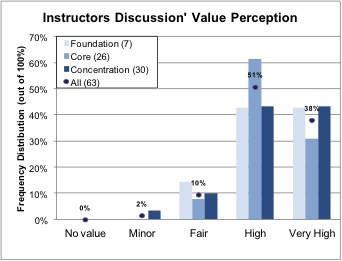
Figure 9. Distributions of instructors' discussion value perceptions at the various program levels
- Relationship between hours spent, load perception, and value perception for instructors. The correlation matrix for instructors is displayed in Figure 10. Course and discussion were highly correlated for hours spent and load perception (r > .6, p < .005), but not on value perception. Given that discussion is a major part of the course (averaging 65% of the total number of hours spent in the course), it is reasonable to conclude here as well that discussion impacted the course (causality direction for the correlations observed). Hours spent on discussion correlated highly with load perceptions of discussion, and with load perceptions of course to a lesser degree (r = .4 to .5 and p = .001 to .005 for these correlations). In contrast to the consistent correlation found between hours spent and load perception, the correlations between value perception and hours spent and between value perception and load perception were weaker or non-existent. Discussion load perception was significantly correlated only with discussion value perception (r = .42, p = .001, n = 63). No correlations were found between value perception and hours spent.
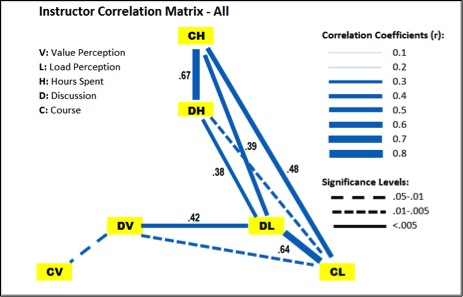
Figure 10. Correlation matrix for students showing relationship between hours spent, load perception, and value perception, for both discussion and course
Learners and Instructors – Response Comparisons and Relationships
- Learners vs. instructors. Figure 11 contrasts the effects of course level and class size on hours spent, load perception, and value perception for learners and instructors. As reported above within the Demographics subsection, the effects of course level and class size are highly related; Concentration courses were associated with smaller class sizes. This summary table is further discussed below in the Discussion section.
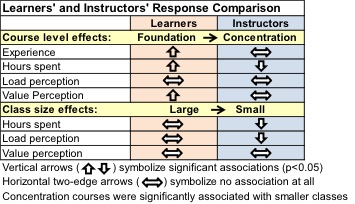
Figure 11. Summary comparing learners' and instructors' responses to the effects of course levels and class sizes
- Learners associated with instructors. The correlations between learners and instructors are displayed in Figure 12 in side-by-side individual group plots (the instructor correlation matrix has been flipped vertically). No significant and/or substantive correlations were found between learners and instructors for hours spent or value perceptions. The only significant and substantive correlation between learners and instructors was evident for the discussion load perceptions (r = .3, p = .001, n = 63).
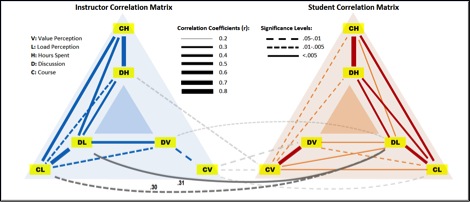
Figure 12. Correlation matrix showing relationships between instructors and students for hours spent, load perception, and value perception, as well as for discussion and course
Discussion
Discussion Guideline Impact
As stated earlier, following the implementation of the Discussion Guideline (Goldman, 2011a) it was hypothesized that the following would be observed: (1) discussion would become the major course engagement conduit for all involved, consuming most of the course time for learners and instructors; (2) discussion would be highly valued by learners, while the load perception of learners and instructors would be capped at a high yet acceptable level; and (3) hours spent on discussion would indicate/predict learners' value perception. As explained below, the first two hypotheses were affirmed, while the third hypothesis could not be affirmed:
- Discussion did become the major engagement conduit for learners and instructors, consuming 55% and 65% of their total course hours, respectively. This was affirmed across all course levels throughout the program with the exception of the Capstone Writing course in which learners focused on developing and writing their projects.
- For both learners and instructors, discussion load perceptions were centered around "medium" (on a scale of "no load" to "very heavy" load) and value perceptions of learners and instructors were centered around "high" (on a scale of "no value" to "very high" value). This was affirmed for learners and instructors across all course levels throughout the program.
- The hypothesis that the value perception for discussion could be gauged and predicted by measuring the hours spent on discussion could not be affirmed and was rejected. No substantive associations were found for learners or instructors between hours spent and value perception for either course or discussion.
Hours Spent and Load Perception
Learners and instructors spent a similar number of hours on discussion; the distributions' means and modes for both groups were in the vicinity of 10 hours a week. Instructors' range of weekly hours spent was clearly limited at 15 hours, as if they operated under a strict budgeted time per course. In contrast, Lazarus (2003) self-reported on a discussion workload (as an instructor) at roughly 3.5 weekly hours. The fact that Lazarus' study involved a mixture of graduate and undergraduate learners, combined with the governance rules for the discussion in that study, could have contributed to the low figure of weekly hours spent on discussion relative to the findings in the present study.
Learners in this study spent 55% of their course time on discussion. Amiel and Orey (2007) reported that graduate learners' "class time" in a synchronous course (comparable to the asynchronous discussion here) was 25-35% of total course hours logged. Differences in discussion grading weights and in temporality of course delivery (synchronous vs. asynchronous) could have accounted for the much larger discussion load reported in the present study. As indicated above, a heavy discussion load was expected in the present study due to the design/application of the Discussion Guideline and grading system.
Learners in this study seemed to have had higher latitude in spending more time on discussion in comparison to instructors. Brown and Green (2009) calculated that graduate learners spent an average of only 65 minutes in weekly reading of discussion posts, although discussions in that instance accounted for only 3-5% of the overall course grade. Although their discussion time is a much lower estimate than that reported in the present study, the difference is readily explainable by the broader definition of discussion activity (reading, researching, and posting) and the much higher allocated grading weight (30-40% of overall course grade) utilized in the present study.
Although generally similar to that of instructors, learners' load perception distribution was more heavily weighted on "heavy" than "medium," possibly reflecting the above difference in distributions of hours spent. More research may be needed to explore the difference in time availability between professional adult instructors and learners, which may account for the abovementioned differences.
Hours spent by learners on discussion increased with the course level. This may reflect a higher expectation of engagement for learners at higher course levels and/or the departure of weak learners from the program at the Foundation course level. The data obtained from this survey are not suitable to resolve these options, but the consistent increase in hours spent on discussion progressively from Foundation-level to Core-level to Concentration-level courses suggests at least a partial role for the engagement/motivation explanation on the learners' part. The relationship between learner motivation and level of engagement in discussion has been well established (Xie, Durrington, & Yen, 2011).
Value Perception
Overall, for both learners and instructors, the discussion engagement was perceived as "high value" earned at a "medium" workload. This is the balance that the Discussion Guideline was aiming to achieve while enabling learners to increase their knowledge throughout the program (Goldman, 2012). As shown here for both learners and instructors, discussion load was likely determined by hours spent, and value perception was related to (more likely determined by) load perception. Value perception was not associated at all with hours spent, but rather with load perception. In a study involving group dynamics in online discussion forums, Lancieri (2008) supported the idea that motivation "is linked to the 'value perception' associated with the constraints of cognitive load" (p. 72). Stated differently, learners might engage in the discussion if they feel that the balance of workload and value will be in their favor.
The above route has obvious limitations, as indiscriminately increasing the hours requirement may have an unfavorable outcome: discussion load might be overwhelming and the program cost (in time and resources) could escalate for both learners and instructors, leading to an unsustainable education model. More implications are discussed below.
Adult Education Model
Romero (2011) used a graphical concept to depict the balance between the demands of family/social, work, and learning circles, and suggested an increase of overlapping or interrelated complexities when some of these circles (i.e., work and/or learning) are managed distantly (i.e., remote work and/or learning). Developing competencies in learners to skillfully manage and balance the lifelong competing and overlapping requirements of life, work, and learning could be a differentiating, competitive strategic objective for online programs.
In the present study, learners and instructors engaged in online discussion share many characteristics. Both groups are primarily professional and experienced adults balancing work with education and personal life. It was interesting to note that the only dependent variable that significantly linked both groups was the discussion load perception, not the hours spent or the value perception. Load perception seemed to be the common, meaningful "behavioral currency" between learners and instructors. The means by which instructors might impact learners' value perception is not through increasing work hours, but rather through reflecting on their own load perception and skillfully managing it for themselves and their students.
The summary table of Learners vs. Instructors above (Figure 11) suggests a different effect to which each group may have responded: learners exclusively responded to course level and instructors primarily responded to class size. For learners, the expected participation in discussion was capped (governed by the Discussion Guideline), making both hours spent and load perception independent of class size; no correlation was found between class size and hours spent by learners on discussion or course.
On the other hand, participating in Concentration-level courses increased both hours spent and value perception. This may reflect the value of more advanced courses, and/or the learners' ability to select their Concentrations (and hence the more valuable courses for them personally). Interestingly, although hours spent was generally highly correlated with load perception, the load perception did not increase as learners progressed to Concentration courses. A possible explanation may involve learner motivation: the higher value perception may have mitigated the increase in load perception even though the hours spent actually increased. In a study conducted by Xie et al. (2011) with a small sample size, motivation (comprised of value perception of discussion and self-competency in online discussion, among other components) was found to increase learner participation in asynchronous online discussion activities.
Instructors' hours spent on discussion and load perception of discussion decreased in smaller classes. Observing the different effects of course level vs. class size on hours spent and load perception (Figure 11), it was deduced that class size was the primary effect for instructors, not course level. Also, for instructors who specialize in their teaching areas, load perception is likely to be independent of course level. The observed effect of class size can be attributed to the Discussion Guideline requiring instructors to read all learners' postings. Consequently, larger classes would impose higher time expenditure and load on instructors. It is worthwhile to note that the above class-size dependency was observable for classes averaging 11.4 learners per class, very close to the optimal online class size of 12 suggested by Tomei (2006) and further discussed in De Gagne and McGill (2010). The results of the present study highlight the sensitivity and criticality of the class-size factor.
Professional adult learners (practitioners and managers) within the 25-40 year age range seeking to update their skills and knowledge represent a fast-growing segment of graduate learners (Brauch & Magda, 2010). To achieve a sustainable work–life–learning balance, the education load must be defined and controlled. Most of the instructing is done by scholarly practitioners. Like learners, practitioner instructors have significant hands-on work experience, and they also need to balance personal life with professional career and educational demands (Goldman, 2012). To better serve them, a higher level of collaboration between professional adult teachers and learners is needed. One way to achieve this is through very engaging, asynchronous delivery courses and discussions, capped by expectations and load. This implication has been exercised in the program studied here: over 50% of the load is related to discussions, which are capped by Discussion Guideline rules and expectations as described by Goldman (2011b).
Management of the balance between course workload (expected work) and value (quality) and the work–life–learning time allocation have traditionally been discussed separately, and for either learners or faculty. Promising strategies have been advanced to control instructor workload (Cho, 2010; Crews et al., 2008; Dunlap, 2005; Ragan & Terheggen, 2003); much discussion has also been presented on the growing issue of time allocation for adult learners (Romero, 2011). Missing from the academic discussion table is a systematic focus on the professional adult stakeholders – learners and instructors – addressing the interrelationships between these two groups with the goal of optimizing the educational process for all stakeholders. Hare Bork (2011) presented qualitative expectations from instructor and learner stakeholders for online courses. Goldman (2011a, 2011b) presents a unified Discussion Guideline for learners and instructors and early exploration of the relationships between them. The hope is that the present study will contribute to an integrated, systemic view of adult learners and instructors engaged in education and subjected to similar constraints of balancing work, life, and learning.
Implications and Next Steps
The following recommendations have been put forward in light of the findings of the study:
- Stay the course: Continue to design courses for high yet defined engagement level through discussions; continue to train the faculty and learners on the Discussion Guideline expectations; maintain the substantive work experience requirement of enrolling students; continue to effect an average class size of 12 students.
- Think of how to design course and discussion to satisfy an acceptable load level (and not just to effect a certain number of weekly hours) to further match the adult instructors' and learners' needs and validate the outcomes. Results in this regard may help to further strengthen the instructor–learner collaboration and value perception of the course taught.
- Follow up with a study that will replace the perceived number of hours spent with a more independent measure (see the limitations of the study below). Such a study is expected to affirm the observation made here about the relatively negligible role of hours spent in comparison to load perception in predicting the value perception.
- More research may be needed to explore the difference in time availability between professional adult instructors and learners and the consequential perceived education load by both. Despite the fact that it is recognized that the expected level of learner workload is a very obvious and critical issue in adult education, very little research has been done on this topic.
Limitations of the Study
The Discussion Guideline, launched prior to conducting the survey, created the expectation of outcomes, which were partially tested as hypotheses to be accepted or rejected. Although not originally conceived for this purpose, conclusions about the outcomes of this study could have been stronger if conditions prior to the introduction of the Discussion Guideline had been tested as well.
Hours spent were estimated and self-reported by learners and instructors. One can always doubt the objectivity of survey responses, thus independent measurement of time spent would have been valuable. The challenge is that not all activities associated with performing in a course or discussion can be independently measured. It is assumed here that inaccuracies and biases were minimal.
More specifically, for various reasons, participants may have been compelled to exaggerate the number of hours they spent as well as their load perceptions. Even if such biases existed, however, it is unlikely that they affected the relationships between the dependent variables and between participating groups in this study. One of the survey questions, asking instructors about the value perception of courses and discussions for learners, may need to be revised in future surveys, as there is a possibility it may have elicited defensive responses from instructors.
References
Amiel, T., & Orey, M. (2007). Do you have the time? Investigating online classroom workload. Journal of Educational Technology Systems, 35(1), 31-43. doi:10.2190/CU8Q-8678-4W03-3587
Andresen, M. A. (2009). Asynchronous discussion forums: Success factors, outcomes, assessments, and limitations. Educational Technology & Society, 12(1), 249-257. Retrieved from http://www.ifets.info/journals/12_1/19.pdf
Bedi, K. (2008). Best practices of faculty in facilitating online asynchronous discussions for higher learner satisfaction. Singapore: U21Global. Retrieved from http://www.u21global.com/PartnerAdmin/ViewContent?module=DOCUMENTLIBRARY&oid=157449
Bocchi, J., Eastman, J. K., & Swift, C. O. (2004). Retaining the online learner: Profile of learners in an online MBA program and implications for teaching them. Journal of Education for Business, 79(4), 245-253. doi:10.3200/JOEB.79.4.245-253
Brauch, M., & Magda, A. (2010, November). Trends, forecasts, implications: The adult and online higher education market. Paper presented at the 16th Sloan Consortium International Conference on Online Learning, Orlando, FL. Abstract retrieved from http://www.sloanconsortium.org/2010aln/presentation/trends-forecasts-implications-adult-and-online-higher-education-market
Brown, A. H., & Green, T. (2009). Time learners spend reading threaded discussions in online graduate courses requiring asynchronous participation. The International Review of Research in Open and Distance Learning, 10(6), 51-64. Retrieved from http://www.irrodl.org/index.php/irrodl/article/view/760/1432
Chen, D., Wang, Y., & Hung, D. (2009). A journey on refining rules for online discussion: Implications for the design of learning management systems. Journal of Interactive Learning Research, 20(2), 157-173. Retrieved from Ed/ITLib Digital Library. (26107)
Cho, S. (2011). How to teach online/distance education courses successfully. In Proceedings of the 27th Annual Conference on Distance Teaching and Learning. Madison, WI: The Board of Regents of the University of Wisconsin System. Retrieved from http://www.uwex.edu/disted/conference/Resource_library/proceedings/46483_2011.pdf
Conceição, S. C. O., & Baldor, M. J. (2009). Faculty workload for online instruction: Individual barriers and institutional challenges. In J. D. Truty (Ed.), Proceedings of the 28th Annual Midwest Research-to-Practice Conference in Adult, Continuing, Community, and Extension Education. Chicago, IL: Northeastern Illinois University.
Crews, T. B., Wilkinson, K., Hemby, K. V., McCannon, M., & Wiedmaier, C. (2008). Workload management strategies for online educators. Delta Pi Epsilon Journal, 50(3), 132-149.
De Gagne, J. C., & McGill, B. A. (2010). Faculty development in online education. Journal of Online Higher Education, 1(7). Retrieved from http://www.theelearninginstitute.org/journal_pdf/JOHE%20-%20Faculty%20Development%20in%20Online%20Education.pdf
Dennen, V. P. (2005). From message posting to learning dialogues: Factors affecting learner participation in asynchronous discussion. Distance Education, 26(1), 127-148. doi:10.1080/01587910500081376
Dunlap, J. C. (2005). Workload reduction in online courses: Getting some shuteye. Performance Improvement, 44(5), 18-25. doi:10.1002/pfi.4140440507
Goldman, Z. (2011a). Balancing quality and workload in asynchronous online discussions: A Win-win approach for learners and instructors. MERLOT Journal of Online Learning and Teaching, 7(2), 313-323. Retrieved from https://jolt.merlot.org/vol7no2/goldman_0611.htm
Goldman, Z. (2011b, November). Value perception and workload for learners and instructors participating in asynchronous discussions. Paper presented at the 17th Annual Sloan Consortium International Conference on Online Learning, Lake Buena Vista, FL. Abstract and presentation slides retrieved from http://www.sloanconsortium.org/conferences/2011/aln/value-perception-and-workload-students-and-instructors-participating-asynchrono
Goldman, Z. (2012, January 17). The new learner engagement model: Creating an educational partnership between students and instructors [Web log post]. Retrieved from http://blog.post.edu/2012/01/6-new-ways-to-improve-student.html
Hare Bork, R. (2011, November). Variation across stakeholders: Instructor and learner expectations of online courses. Paper presented at the 17th Sloan Consortium International Conference on Online Learning, Lake Buena Vista, FL. Abstract and presentation slides retrieved from http://www.sloanconsortium.org/conferences/2011/aln/variation-across-stakeholders-instructor-and-student-expectations-online-course
Lancieri, L. (2008). Relation between the complexity of individuals' expression and groups dynamic in online discussion forums. The Open Cybernetics & Systemics Journal, 2(1), 68-82. doi:10.2174/1874110X00802010068
Lazarus, B. (2003). Teaching courses online: How much time does it take? Journal of Asynchronous Learning Networks, 7(3), 47-54. Retrieved from http://www.sloanconsortium.org/sites/default/files/v7n3_lazarus_1.pdf
Mandernach, B. J., Dailey-Hebert, A., & Donnelli-Sallee, E. (2007). Frequency and time investment of instructors' participation in threaded discussions in the online classroom. Journal of Interactive Online Learning, 6(1), 1-9. Retrieved from http://www.ncolr.org/jiol/issues/pdf/6.1.1.pdf
Ragan, L. C., & Terheggen, S. L. (Eds.). (2003). Effective workload management strategies for the online environment. University Park, PA: The Pennsylvania State University World Campus. Retrieved from http://www.worldcampus.psu.edu/pdf/fac/workload_strat.pdf
Romero, M. (2011). Distance learners' work life learning balance. International Journal of Instructional Technology and Distance Learning, 8(5), 43-48. Retrieved from http://www.itdl.org/Journal/May_11/May_11.pdf
Scheuermann, M. (2005a). Course quality and instructor workload: Pt. 1. Distance Education Report, 9(1), 4-7. Retrieved from http://www.magnapubs.com/newsletter/distance-education-report/story/734/
Scheuermann, M. (2005b). Course quality and instructor workload: Pt. 2. Distance Education Report, 9(2), 4-6. Retrieved from http://www.magnapubs.com/newsletter/distance-education-report/story/741/
Tomei, L. A. (2006). The impact of online teaching on faculty load: Computing the ideal class size for online courses. Journal of Technology and Teacher Education, 14(3), 531-541. Retrieved from Ed/ITLib Digital Library. (5626)
Wang, Y., & Chen, V. (2008). Essential elements in designing online discussions to promote cognitive presence – a practical experience. Journal of Asynchronous Learning Networks, 12(3-4), 157-177. Retrieved from http://www.sloanconsortium.org/sites/default/files/v12n3_wang_0.pdf
Xie, K., Durrington, V., & Yen, L. L. (2011). Relationship between learners' motivation and their participation in asynchronous online discussions. MERLOT Journal of Online Learning and Teaching, 7(1), 17-29. Retrieved from https://jolt.merlot.org/vol7no1/xie_0311.htm
Appendix A: Post University Online MBA Discussion Guideline
The approach taken at Post University's online MBA program was inclusive and collaborative, involving a commitment shared by all teaching faculty, full-time members, and adjuncts. A Discussion Guideline including minimum requirements and best practices was launched. Weekly discussion typically included three instructor-facilitated question threads. Discussion grade counted toward 30-40% of the total course grade.
Instructors are required to read all postings, participate at least four days a week, facilitate, and grow the discussion within the week's objectives. Instructors' presence type is teaching and informative, delivered in an informal social context. Learners are required to substantively contribute at least four times on each question thread, responding to the seed question and peers over at least three different days of the week, starting no later than Wednesday (each week starts on Monday). Postings are expected to be evidence based, supported by personal experience and/or research.
Appendix B: Post University Online MBA Program Profile
Program Characteristics
- Roughly 500 learners in the program
- Fifteen courses, 45 credits total, including Capstone (6 credits)
- Accelerated, eight-week courses program, each week starts on Monday
- On average, learners take 1.3 classes concurrently (more/less at the Concentration/Foundationlevels)
- Six modules in an academic year
- Program includes courses in: Foundation (three basic/leveling courses) --> Core (six program core courses) --> Concentrations (elective four discipline-focused course) --> Capstone (two research and writing courses)
- Asynchronous discussions, facilitated and directed at all times
- Typically three weekly discussion threads
- Discussions count typically for 30-40% of course grade
- Course and discussions delivered on Blackboard
Learners' and Instructors' Common Characteristics
- Professionals and practitioners
- Have substantive work experience (part of admission criteria)
- Need to balance work/career, teaching/education, and family life
Appendix C: Instructor and Learner Surveys
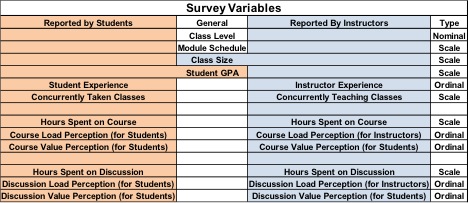
Learner Survey
Record learner email and code name, date, module, and year (data).
- Select the course and section number (from a drop down list).
- Enter the number of additional MBA courses taken concurrently at Post University with the course you report on now (0, 1, 2).
- Enter your GPA coming into the class (x.xx number).
- Looking back, how much relevant experience (previous exposure to the taught content) did you have coming into this course? (1-5 scale: 1 = none; 2 = negligible; 3 = some; 4 = fair; 5 = substantive)
- On average, how many hours per week have you spent on this course (including reading, discussion, assignment, and communication with peers and instructor)? (discrete number) [currently on our course evaluation survey]
- How would you rate the overall course load for you in this class? (1-5 scale: 1 = no load; 2 = minor load; 3 = medium load; 4 = heavy load; 5 = very heavy load)
- How would you rate the overall course value for you in this class? (1-5 scale: 1 = no value; 2 = minor value; 3 = fair value; 4 = high value; 5 = very high value)
- On average, how many hours per week have you spent on discussions (including reading, researching, and posting)? (discrete number)
- How would you rate the overall discussion load for you in this class? (1-5 scale: 1 = no load; 2 = minor load; 3 = medium load; 4 = heavy load; 5 = very heavy load)
- How would you rate the overall discussion value for you in this class? (1-5 scale: 1 = no value; 2 = minor value; 3 = fair value; 4 = high value; 5 = very high value)
Instructor Survey
Record instructor email and code name, date, module, and year (data).
- Select the course and section number (from a drop down list, same as learner's above).
- Enter the number of additional courses you teach concurrently with the course you report on now (0, 1, 2).
- Enter number of learners in class at the time of the survey (discrete number).
- How would you rate your professional experience level with the course content? (1-5 scale: 1 = average; 2 = above average; 3 = substantial; 4 = very high; 5 = top expert)
- On average, how many hours per week have you spent on teaching this course (including management, discussion, and grading; not including development)? (discrete number)
- How would you rate the overall course load for you in this class? (1-5 scale: 1 = no load; 2 = minor load; 3 = medium load; 4 = heavy load; 5 = very heavy load)
- How would you rate the overall course value for your learners in this class? (1-5 scale: 1 = no value; 2 = minor value; 3 = fair value; 4 = high value; 5 = very high value)
- On average, how many hours per week have you spent specifically on discussions (including reading, posting, and grading; not including development)? (discrete number)
- How would you rate the overall discussion load for you in this class? (1-5 scale: 1 = no load; 2 = minor load; 3 = medium load; 4 = heavy load; 5 = very heavy load)
- How would you rate the overall discussion value for your learners in this class? (1-5 scale: 1 = no value; 2 = minor value; 3 = fair value; 4 = high value; 5 = very high value)
Appendix D: Ad-Hoc Definitions
Discussion: Online information-sharing and exchange forum included in (part of) the course; the likely causality direction is discussion --> course.
Hours spent: Chronological count of weekly hours spent as reported by learners.
Load perception: Impact of hours spent in the context of one's weekly available time and perceived challenge level of course/discussion.
Value perception: Short-term tangible return on time, effort, and resources/money spent.